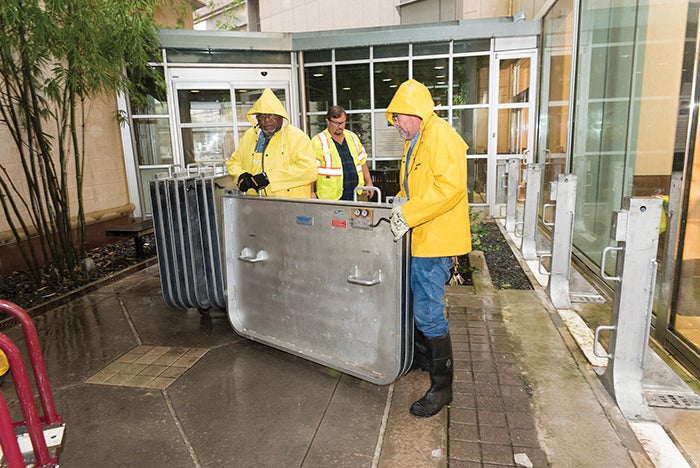Special report
Texas hospitals share their Harvey experiences
Three facilities leaders detail how they prepared for and recovered from Hurricane Harvey
|

MD Anderson staff install flood gates prior to Hurricane Harvey
Image courtesy of University of Texas MD Anderson Cancer Center
Hurricane Harvey, which struck the Houston area in 2017 and caused $125 billion in damage, provides a recent test case for flooding preparation and recovery. In this sidebar, three health care facility professionals recount the experiences of their hospitals.
Matthew L. Berkheiser, DrPH, CIH, CSP, associate vice president and chief safety officer at the University of Texas MD Anderson Cancer Center, Houston:
- IMPACT. “We had relatively minimal damage to our buildings. We did not lose power or critical equipment during the event. Some water entered our buildings due to the back pressure placed on the city stormwater drainage system. Fortunately, we have over 70 flood gates that we installed prior to Harvey. So, we maintained operations, with over 500 patients in our inpatient towers, and we also had some patients stay in our connected hotel.”
- PREPARATION. “We staged our flood gates, verified our food reserves and maintained staffing to care for 500 patients. We also completed appointments for approximately 400 outpatients, had sandbags and other supplies available, and had all of our hazardous waste and other waste containers at our back docks emptied prior to the storm arriving.”
- RESPONSE. “We activated our Incident Command team prior to the storm and had operations and maintenance staff, as well as some contractors, on-site prior to the storm.”
- RECOVERY. “We did a slow ramp-up, as high water in surrounding areas impeded our patients and some of our staff. We were able to care for our inpatients and see some critical patients as we ramped up to normal operations. Our high-water vehicles helped move some of our staff and supplies around. We returned to normal operations in about seven days.
- LESSONS. “We have to continue to keep in touch with other entities and partners. We’ve engaged with a professional meteorology service to help us understand potential weather impacts. We used to have our ride-out team sleep in our outpatient clinics, but now we plan to sleep in other areas to return patient care areas to normal operations faster. And since Harvey, we’ve activated our incident command more than 12 times for either real events or drills. Practice is key to success.”
Terry Elliott, director of construction programs for Harris Health System, which includes Ben Taub Hospital, Houston:
- IMPACT. “We suffered flooding due to storm backflow through the hospital’s drainage lines. That caused piping to rupture and significant flooding to occur within the hospital’s lower levels. However, we managed to maintain our above-ground emergency generators and critical infrastructure systems remained safe and functioning.”
- PREPARATION. “The hospital’s emergency management plans were reviewed. Supply and staffing levels were monitored as well as patient assessment activities by the medical staff. Close coordination and communications with city and county emergency management agencies were key in getting updates on the storm system and the resources available.”
- RESPONSE. “The hospital’s emergency plans were activated. Communications with local authorities were ongoing. Preplanned ride-out staff were positioned at each location, and non-pavilion system staff were available to assist with emergency supplies, communications and engineering-type support.”
- RECOVERY. “Although normal patient care activities resumed fairly quickly, there were multiple support and ancillary departments that had to be temporarily relocated. Infrastructure repairs went on for several months. The build-back of the direct flooding areas took much longer — six to eight months.”
- LESSONS. “Prepositioning and partnering with flood and disaster recovery specialists is key in getting back up and running quickly. For the infrastructure systems and equipment, assessing the flood plain levels is critical. To keep these systems operational, internal dry flood-proofing methods that are relatively inexpensive and very effective can be implemented. An engineering assessment of storm and sanitary systems is a good preventive measure.”
Jacob McCall, director of engineering services, Memorial Hermann Sugar Land Hospital, Texas:
- IMPACT. “Our hospital was evacuated, because the river that winds around us was projected to breach the levees. Fortunately, the river level plateaued below the levee height, and we were able to make any repairs needed prior to our soft re-opening.”
- PREPARATION. “We stocked up on sandbags and stacked them in front of our generator room, switch gear room and another large electrical room on our first floor. We made sure the diesel tank was full and conducted an annual load bank test to ensure that our generators were operating properly. We had an ample supply of water and stocked up on additional supplies.”
- RESPONSE. “We initiated our incident command center and called in our A team employees to ride out the storm. After the storm, our B team came in and relieved the A team.”
- RECOVERY. “We repaired various leaks quickly, coordinated demolition and installed new sheetrock within a few days. We had enough carpet tile stock to replace anything damaged in the major lobbies.”
- LESSONS. “The call to evacuate was the right call. We learned to have a better process to control the parking lot after evacuation.”





